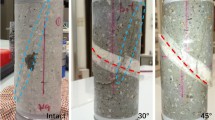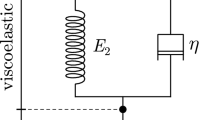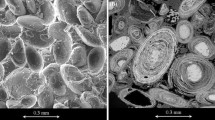Abstract
A large deformation thermomechanical model is developed for shock loading of a material that can exhibit elastic and inelastic anisotropy. Use is made of evolution equations for a triad of microstructural vectors \(\mathbf{m}_{\mathrm{i}}\,(\hbox {i}=1,2,3)\) which model elastic deformations and directions of anisotropy. Specific constitutive equations are presented for a material with orthotropic elastic response. The rate of inelasticity depends on an orthotropic yield function that can be used to model weak fault planes with failure in shear and which exhibits a smooth transition to isotropic response at high compression. Moreover, a robust, strongly objective numerical algorithm is proposed for both rate-independent and rate-dependent response. The predictions of the continuum model are examined by comparison with exact steady-state solutions. Also, the constitutive equations are used to obtain a simplified continuum model of jointed rock which is compared with high fidelity numerical solutions that model a persistent system of joints explicitly in the rock medium.






Similar content being viewed by others
References
Bar-on E, Rubin MB, Yankelevsky D (2003) Thermomechanical constitutive equations for the dynamic response of ceramics. Int J Solids Struct 40:4519–4548
Besseling JF (1966) A thermodynamic approach to rheology. In: Parkus I, Sedov LI (eds) Proceedings of the IUTAM symposium on irreversible aspects of continuum mechanics and transfer of physical characteristics in moving fluids, Vienna. Springer, Wein, 1968, pp 16–53
Bodner SR (1987) Review of unified elastic-viscoplastic theory. In: Miller (ed) Unified constitutive equations for creep and plasticity. Elsevier, Barking, pp 273–301
Eckart C (1948) The thermodynamics of irreversible processes. IV. The theory of elasticity and anelasticity. Phys Rev 73:1075–1078
Flory P (1961) Thermodynamic relations for high elastic materials. Trans Faraday Soc 57:829–838
Green AE, Naghdi PM (1977) On thermodynamics and the nature of the second law. Proc R Soc Lond A357:253–270
Green AE, Naghdi PM (1978) The second law of thermodynamics and cyclic processes. ASME J Appl Mech 45:487–492
Hoek E, Brown E (1997) Practical estimates of rock mass strength. Int J Rock Mech Min Sci 34:1165–1186
Hollenstein M, Jabareen M, Rubin MB (2013) Modeling a smooth elastic-inelastic transition with a strongly objective numerical integrator needing no iteration. Comput Mech 52:649-667. Erratum, Computational Mechanics 55
Lee EH (1969) Elastic-plastic deformation at finite strain. ASME J Appl Mech 36:1–6
Lee EH, Liu DT (1967) Finite-strain elastic-plastic theory with application to plane-wave analysis. J Appl Phys 38:19–27
Lekhnitskii SG (1963) Theory of elasticity of an anisotropic elastic body. Holden-Day, San Francisco
Leonov AI (1976) Nonequilibrium thermodynamics and rheology of viscoelastic polymer media. Rheol Acta 15:85–98
Malvern LE (1951) Trans ASME Ser E J Appl Mech 73:269
Naghdi PM (1990) A critical review of the state of finite plasticity. J Appl Math Phys (ZAMP) 41:315–394
Naghdi PM, Trapp JA (1975) The significance of formulating plasticity theory with reference to loading surfaces in strain space. Int J Eng Sci 13:785–797
Papes O, Mazza E (2009) Numerical implementation of an elasto-viscoplastic material law for FE calculations of biological tissues at finite deformations. ETH Technical Report, Zurich
Perzyna P (1963) The constitutive equations for rate sensitive plastic materials. Q Appl Mech 20:321–332
Rubin MB (1986) An elastic-viscoplastic model for metals subjected to high compression. ASME J Appl Mech 54:532–538
Rubin MB (1992) Hyperbolic heat conduction and the second law. Int J Eng Sci 30:1665–1676
Rubin MB (1994a) Plasticity theory formulated in terms of physically based microstructural variables, Part I: theory. Int J Solids Struct 31:2615–2634
Rubin MB (1994b) Plasticity theory formulated in terms of physically based microstructural variables, Part II: examples. Int J Solids Struct 31:2635–2652
Rubin MB (2012) Removal of unphysical arbitrariness in constitutive equations for elastically anisotropic nonlinear elastic-viscoplastic solids. Int J Eng Sci 53:38–45
Rubin MB, Attia AV (1996) Calculation of hyperelastic response of finitely deformed elastic-viscoplastic materials. Int J Numer Meth Eng 39:309–320
Rubin MB, Papes O (2011) Advantages of formulating evolution equations for elastic-viscoplastic materials in terms of the velocity gradient instead of the spin tensor. J Mech Mater Struct 6:229–243
Simo JC (1992) Algorithms for static and dynamic multiplicative plasticity that preserve the classical return mapping schemes of the infinitesimal theory. Comput Meth Appl Mech Eng 99:61–112
Simo JC, Hughes TJR (1998) Computational inelasticity. Springer, New York
Vorobiev O, Ezzedine S, Antoun A, Glenn L (2015) On the generation of tangential ground motion by underground explosions in jointed rock. Geophys J Int 200:1651–1661
Acknowledgments
The Source Physics Experiments (SPE) would not have been possible without the support of many people from several organizations. The authors wish to express their gratitude to the National Nuclear Security Administration, Defense Nuclear Nonproliferation Research and Development (DNN R&D), and the SPE working group, a multi-institutional and interdisciplinary group of scientists and engineers. This work was done by Lawrence National Laboratory under Contract DE-AC52-07NA27344. This research was also partially supported by MB Rubin’s Gerard Swope Chair in Mechanics.
Author information
Authors and Affiliations
Corresponding author
Appendices
Appendix 1: Constitutive coefficients for the linearized purely mechanical theory of an orthotropic material
1.1 An orthotropic material with seven material constants
For the purely mechanical theory, the Helmholtz free energy \({\uppsi }_{\mathrm{d}}\) is taken in the form (4.7) and the Helmholtz free energy \({\uppsi }_{\mathrm{e}}\) is taken in the form (4.18). Since \(\hbox {K}_{\mathrm{ijkl}}\) satisfies the restrictions (4.8), the constants \(\{\hbox {K}_{\mathrm{1122}}\), \(\hbox {K}_{\mathrm{1133}}\), \(\hbox {K}_{\mathrm{2233}}\}\) are given by (7.3) so this orthotropic material is characterized by the reference density \({\uprho }_{\mathrm{0}}\) and seven independent constants
Moreover, using (3.14), (4.10) and (4.18) yields an expression for the stress in the form
For the purely mechanical linearized theory the strain energy function \(\Sigma \) per unit mass and the stress components \(\hbox {T}_{\mathrm{ij}}\) can be expressed in the forms
where \(\tilde{\hbox {K}}_{\mathrm{ijkl}}\) has the same symmetries as \(\hbox {K}_{\mathrm{ijkl}}\) associated with the first set of Eq. in (4.8) but \(\{\tilde{\hbox {K}}_{\mathrm{nnkl}}, \tilde{\hbox {K}}_{\mathrm{ijnn}}\}\) do not vanish. For small elastic strains \(\hbox {e}_{\mathrm{ij}}\)
so \({\uppsi }_{\mathrm{e}}\) in (4.18) can be approximated by
Then, with the help of (4.7) the linearized strain energy is given by
where \(\hbox {e}_{\mathrm{kl}}^{\prime }\) is the deviatoric part of the linearized strain \(\hbox {e}_{\mathrm{ij}}\). Consequently, for the linearized version of the orthotropic model discussed in Sect. 7 it follows that
Moreover, the standard expressions for strain as a function of stress for an orthotropic material can be written in the forms [12]
where \(\{\hbox {E}_{\mathrm{1}}\), \(\hbox {E}_{\mathrm{2}}\), \(\hbox {E}_{\mathrm{3}}\}\) are Young’s moduli, \(\{{\upnu }_{\mathrm{12}}\), \({\upnu }_{\mathrm{21}}\), \({\upnu }_{\mathrm{13}}\), \({\upnu }_{\mathrm{31}}\), \({\upnu }_{\mathrm{23}}\), \({\upnu }_{\mathrm{32}}\}\) are Poisson’s ratios and \(\{\hbox {G}_{\mathrm{12}}\), \(\hbox {G}_{\mathrm{13}}\), \(\hbox {G}_{\mathrm{23}}\}\) are shear moduli. Also, the symmetry of the constitutive equation requires
It can be shown that the expressions (7.3), (7.5)-(7.7) cause (11.7) to be consistent with (11.8) when the values of the Poisson ratios are given by
Moreover, using the fact that \(\hbox {e}_{33}^{\prime }= - (\hbox {e}_{11}^{\prime }+\hbox {e}_{22}^{\prime })\), the strain energy function \({\uprho }_{\mathrm{0}}{\uppsi }_{\mathrm{d}}\) can be expressed in the simplified form
with
It then follows that \({\uprho }_{\mathrm{0}}\Sigma \) in (11.6) will be a positive definite function of the strain \(\hbox {e}_{\mathrm{ij}}\) when
which are satisfied by the restrictions (7.8).
In summary, the orthotropic material is characterized by the seven material constants
which satisfy the restrictions (7.8). Then, the non-trivial values of \(\hbox {K}_{\mathrm{ijkl}}\) are determined by (7.3), (7.6) and (7.7), and the values of \(\{\hbox {E}_{\mathrm{1}}\), \(\hbox {E}_{\mathrm{2}}\), \(\hbox {E}_{\mathrm{3}}\), \({\upnu }_{\mathrm{12}}\), \({\upnu }_{\mathrm{21}}\), \({\upnu }_{\mathrm{13}}\), \({\upnu }_{\mathrm{31}}\), \({\upnu }_{\mathrm{23}}\), \({\upnu }_{\mathrm{32}}\}\) are determined by (7.5) and (11.10). Moreover, it can be seen from (7.5) and (7.8) that \(\{\hbox {E}_{\mathrm{1}}\), \(\hbox {E}_{\mathrm{2}}\), \(\hbox {E}_{\mathrm{3}}\}\) have the ranges
1.2 An orthotropic material with five material constants
For the special case when
it follows that the Young’s moduli are equal to E and the Poisson’s ratios are equal to \({\upnu }\)
with
which yields an orthotropic material characterized by five material constants
1.3 An orthotropic material with three material constants
The special case of (11.18) with all shear moduli being equal
yields an orthotropic material characterized by three material constants
1.4 An isotropic material with two material constants
The special case of (11.20) with Poisson’s ratio specified by
yields an isotropic material.
Appendix 2: Approximate elastic wave speeds
In order to develop approximate expressions for relevant wave speeds it is assumed that the pressure \(\hbox {p}_{\mathrm{e}}\) can be approximated by the Hugoniot pressure \(\hbox {p}_{\mathrm{H}}\) in (4.14) so with the help of (3.14) and (4.10) the stress T is approximated by
For elastic response, the rate of inelasticity \(\mathbf{L}_{\mathrm{p}}\) is neglected in (1.8) and use is made of (3.1), (3.5), (4.8) and (4.14) to deduce that
where the Hugoniot bulk modulus \(\hbox {K}_{\mathrm{H}}\) is given by
Next, consider small deformations from a hydrostatic state of stress with
and let \(\hbox {D}_{\mathrm{ij}}\) be the components of the rate of deformation tensor D relative to rectangular Cartesian base vectors \(\mathbf{e}_{\mathrm{i}}\) which are parallel to \(\mathbf{m}_{\mathrm{i}}\), such that
with the components \(\hbox {T}_{\mathrm{ij}}\) of the stress T given by (9.7). Then, for the orthotropic material characterized by (7.3), (7.6) and (7.7) it follows that for uniaxial strains in the \(\mathbf{e}_{\mathrm{i}}\) directions
and for simple shears
Thus, the uniaxial strain wave speeds for waves in the \(\mathbf{e}_{\mathrm{i}}\) directions are approximated by
and the shear wave speeds are approximated by
These values can be used to limit the time step in explicit wave propagation codes.
Rights and permissions
About this article
Cite this article
Rubin, M.B., Vorobiev, O. & Vitali, E. A thermomechanical anisotropic model for shock loading of elastic-plastic and elastic-viscoplastic materials with application to jointed rock. Comput Mech 58, 107–128 (2016). https://doi.org/10.1007/s00466-016-1284-0
Received:
Accepted:
Published:
Issue Date:
DOI: https://doi.org/10.1007/s00466-016-1284-0




